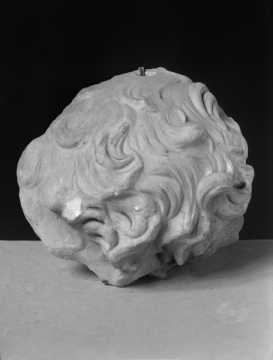Explore Collections


You are here:
CollectionsOnline
/
Fragment of a male head: replica of the Ares Ludovisii
Browse
Curatorial note
This thin and hollow (either broken or concave) fragment comprises the top and scalp area of the head of a young man with rich curly hair hanging in two small curls below a mat of hair above the forehead and growing thinner above a ridge well above the ears and running about the corona of the head.
These subtly marked characteristics of the rather slender evidence presented by this fragment reveal it as probably the remains of a copy of the Ares Ludovisi.1 The Ares Ludovisi and other versions of the figure have been identified not only (and more correctly) with the Greek sculptor Lysippos but also with Skopas (or Scopas).2
1 Compare example illustrated in G. Lippold, Jahrbuch des Deutschen Archäologischen Instituts, XXXVI, 1911, p. 277, fig. 7f.; Aurigemma, Terme di Diocleziano, p. 107, no. 287, pl. XXI; C.P. Picard, Manuel d'archéologie grecque: La sculpture, Paris, 1935, III, I, pp. 720 ff., figs. 321-323; and for a comparative consideration of the replicas, C. Praschniker, in Jahreshefts des Oesterreichischen Archäologischen Institutes, XXI-XXII, 1922-1924, pp. 203-221.
The Ludovisi Ares is an Antonine Roman marble sculpture of Mars, a fine 2nd-century copy of a late 4th-century BC Greek original. Hence, in the statue's title, the Roman god of war is given his Greek name, Ares. The young and beardless God is shown seated on a trophy of arms, with a smaller figure of Eros by his side. The sculpture was probably originally part of the temple of Mars (founded in 132 BC in the Campus Martius in Rome, of which few traces remain) for it was rediscovered in 1622 near the site of the church of San Salvatore in Campo, on that site. Pietro Santi Bartoli recorded in his notes that it had been found near the Palazzo Santa Croce in Rione Campitelli during the digging of a drain (Haskell and Penny, Taste and the Antique,1981, p.260) The sculpture found its way into the collection of Cardinal Ludovico Ludovisi (1595-1632) the nephew of Pope Gregory XV at the splendid villa and gardens he built near Porta Pinciana. Winckelmann called the Ludovisi Ares the most beautiful Mars preserved from Antiquity in his catalogue of the Ludovisi collection.
2 See G. Lippold, Handbuch der Archäologie, III, 1, Munich, 1950, p. 289 and note 11; W. Helbig, Führer durch die Sammlungen in Rom, fourth edition, III, Tübingen, 1969, pp. 268-270, no. 2345 (in this edition the text was written by Paul Zanker).
These subtly marked characteristics of the rather slender evidence presented by this fragment reveal it as probably the remains of a copy of the Ares Ludovisi.1 The Ares Ludovisi and other versions of the figure have been identified not only (and more correctly) with the Greek sculptor Lysippos but also with Skopas (or Scopas).2
1 Compare example illustrated in G. Lippold, Jahrbuch des Deutschen Archäologischen Instituts, XXXVI, 1911, p. 277, fig. 7f.; Aurigemma, Terme di Diocleziano, p. 107, no. 287, pl. XXI; C.P. Picard, Manuel d'archéologie grecque: La sculpture, Paris, 1935, III, I, pp. 720 ff., figs. 321-323; and for a comparative consideration of the replicas, C. Praschniker, in Jahreshefts des Oesterreichischen Archäologischen Institutes, XXI-XXII, 1922-1924, pp. 203-221.
The Ludovisi Ares is an Antonine Roman marble sculpture of Mars, a fine 2nd-century copy of a late 4th-century BC Greek original. Hence, in the statue's title, the Roman god of war is given his Greek name, Ares. The young and beardless God is shown seated on a trophy of arms, with a smaller figure of Eros by his side. The sculpture was probably originally part of the temple of Mars (founded in 132 BC in the Campus Martius in Rome, of which few traces remain) for it was rediscovered in 1622 near the site of the church of San Salvatore in Campo, on that site. Pietro Santi Bartoli recorded in his notes that it had been found near the Palazzo Santa Croce in Rione Campitelli during the digging of a drain (Haskell and Penny, Taste and the Antique,1981, p.260) The sculpture found its way into the collection of Cardinal Ludovico Ludovisi (1595-1632) the nephew of Pope Gregory XV at the splendid villa and gardens he built near Porta Pinciana. Winckelmann called the Ludovisi Ares the most beautiful Mars preserved from Antiquity in his catalogue of the Ludovisi collection.
2 See G. Lippold, Handbuch der Archäologie, III, 1, Munich, 1950, p. 289 and note 11; W. Helbig, Führer durch die Sammlungen in Rom, fourth edition, III, Tübingen, 1969, pp. 268-270, no. 2345 (in this edition the text was written by Paul Zanker).
Rome; collected in Rome by Charles Heathcote Tatham for the architect Henry Holland during the 1790s. See Cornelius Vermeule, unpublished Catalogue of the Antiquities at Sir John Soane's Museum, Introduction, transcription of Tatham letters, List 3, no.39.
Literature
Tatham: Drawings, 8.
Soane collections online is being continually updated. If you wish to find out more or if you have any further information about this object please contact us: worksofart@soane.org.uk


